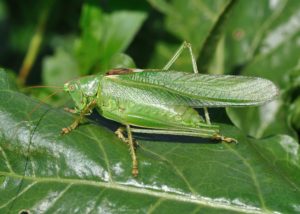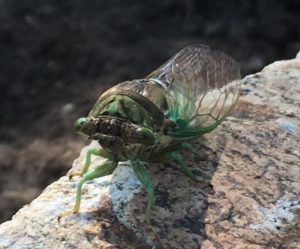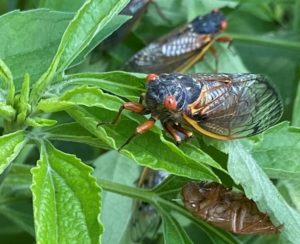Hello fellow readers, You may know I record a podcast version of our column from the screened porch. In doing so this week, the loud shrill of annual cicadas was overwhelming. Not to be confused with the hubbub warning about Brood-X periodic cicadas all over the news earlier in the season. Which brings a question, what’s the Brood-X Cicada 2021 recap of where they invaded?
Annual Cicadas vs. Periodic Cicadas
Annual cicadas, despite their name, emerge every four to seven years and not by the millions all at the same time like Brood-X. So it’s a different batch of them each year. And because there are fewer of them, they are quieter than the periodic ones.
Not much seems to have come from the anticipated Brood-X invasion. Well, at least not in our neck of the woods in Northwest New Jersey.
What came of Brood-X?
They predicted their emergence would reach a peak in early to mid-June. I heard a few Brood-X-ers singing in the trees and came upon a molted exoskeleton— essentially the hard outside skin some call the “outside skeleton” that protects insects. I posted a photo on Instagram, asking if anyone knows what came of Brood-X?
Rob, a buddy from my days at The Record newspaper, writes, “I’ve seen one in my yard in Clifton, NJ, and it was dead.”
Debbie from Costa Mesa, CA, writes, “I haven’t seen any here! They may have been wiped out by murder hornets (a hot topic there.) Who can keep up with headlines?” adding the smiling face with tears of laugher emoji.
Lifecycle of Annual & Periodic Cicadas
Just as the annual cicadas now buzzing in the trees, periodic cicadas emerge from the ground and molt to become adults with wings. Then they find their way onto deciduous trees and shrubs to mate.
The loud shrill (sounding like see-see-see-see) are the males singing to attract the females. But it’s the females that can cause significant damage when cutting slits into branches to lay eggs. On a positive note, they don’t sting or bite and provide protein for wildlife. And now people too? Yup, many cicada recipes raced around social media. Talk about making folks queasy.
Cicada Safari mobile app is compiling data.
So back to searching where Brood-X most heavily invaded. I came upon a story about the Cicada Safari mobile app. One hundred ninety-six thousand folks downloaded the app and submitted over 560,000 photos and 28,000 videos. A great success!
They are now compiling the data to determine how Brood-X’s geography has changed and the impact on different tree species compared to the last time they emerged seventeen years ago, in 2004. And to think we didn’t have iPhones, Androids, or social media then.
My due diligence didn’t lead to any updated maps of where they most heavily emerged. I heard Princeton, NJ was a hot spot and reached out to an associate horticulturist Richard McCoy who enhances and manages properties using organic and ecological practices, native plants, as well as a full suite of battery-powered lawn and landscape tools.
Brood-X Cicada damage
“Oh yeah, we had Brood-X in Princeton!” he said and sent photos and videos of the critters loaded on shrubs and perennials there.
We won’t know the full impact from the slits they cut into branches for a season or two. Though Richard reports, “the damage is evident now in the tip dieback in most softer terminal new growth of trees and shrubs.” He sent a photo of an oak tree with leaves already browned at the tips of branches.
Cicadas sing by Day and Katydids by Night.
After hearing the loud shrills of the cicadas on the podcast recordings, I considered re-recording the episode in the evening, but that’s when the sounds of Katydids (Tettigoniidae) pipes in. You know, those docile grasshopper-like critters that look like leaves camouflaging themselves in the garden. They sing Katy-did Katy-didn’t over and over again in the trees starting in July through October.

Katydid Photo By Quartl, CC BY-SA 3.0 via Wikimedia Commons
Thank goodness the Garden Dilemmas Podcast producer can dial down the volume of nature’s chorus if need be. Suppose we do the same with “news” providers that seem mainly motivated to sell fear. Thankfully we have nature and our gardens that help heal and grow our lives.
Garden Dilemmas? AskMaryStone@gmail.com (and your favorite Podcast App.)
A tidbit of this story is featured in Episode 33 of the Garden Dilemmas Podcast:
A special thank you to Richard McKoy for sharing his expertise and providing the photographs of the Brood-X Cicadas seen here. Link to Richard A. McCoy Horticultural Services Inc.
Link to a previous column, Cicadas Sing Back to School






